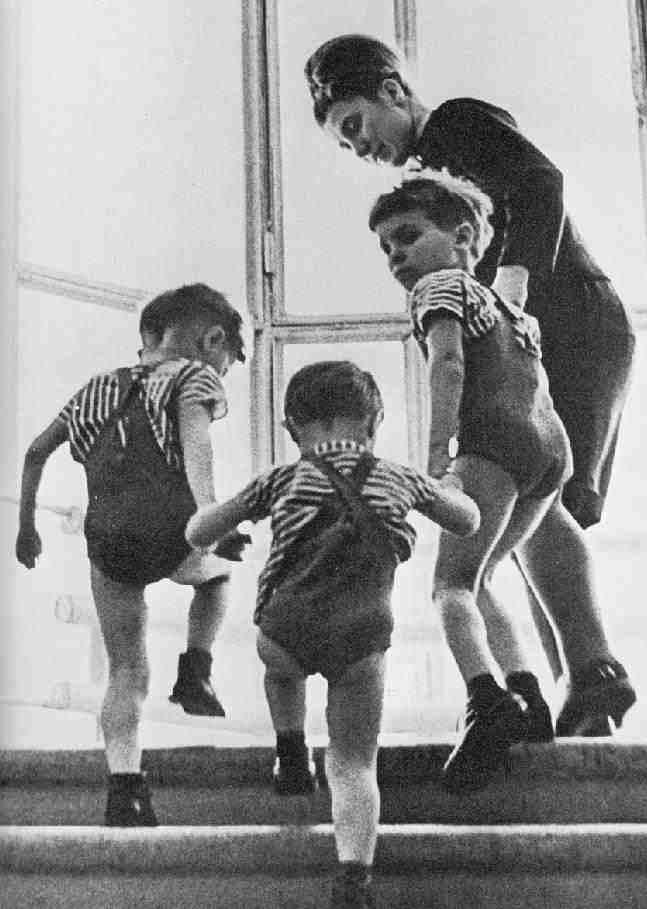
Russian Boys' Clothes: Activities--Selection and Training

Figure 1.--The photograph here shows three small boys of kindergarten age (about 4 or 5 years old). The photograph was taken at the Institute of Pediatrics in Moscow (figure 1). The children were being studied by doctors at the Institute to see if they were psychologically and physically predisposed for certain career paths in the Soviet Union such as becoming athletes or mathemeticians.
|
|
Some of the activities here are recreational or in nature or realte to personal development for most boys. A small number of boys, however, have the inate talent and ability to develop into gifted musiscians, scholars, or world class atheletes. The Soviet Union placed a great emphasis in identifying talented individuals and then devekoping training programs to assist these children in achieving their potentials. The Soviet Union as it evolved was anything but demanding equal education for all. As it developed not only did talented individuals get access to special programs, but so did the children of important Party members, government officials, and ranking military officers.
Soviet Efforts
The Soviet Union put considerable effort finding and selecting children with talent to be developed. This included among other aspects psychologists probing the personalities and skills of very young children. There is something troubling about white robed Soviet doctors stufying very young children to the Western mindset. It rather smacks of Brave New World and of coorse the Soviet practice of using psychiatrists to traet disidence as a social disease still lingers. Of course the Western system where the financial standing and background of the parents are critical factors is not that edyfying either. One aspect of the Soviet system that is not alltogether clear to us is what about the ordinary child. Certainly the Soviet system of finding gifted children at an early age was helpful in tarining world-class atheletes, academics, musicians, dancers, ect. that could reflect well on the Soviet state. But did the Soviet system offer the average child support in developing his or her modest talent that could enable them to play and enjoy music for personal satifacation as an adult. We are not sure that the Soviet system dealt well this desire for individual development, but our information on music in the Soviet Union is still quite limited.
Institute of Pediatrics
The photograph here shows three small boys of kindergarten age (about 4 or 5 years old). The photograph was taken at the Institute of Pediatrics in Moscow (figure 1). These Moscow children were being studied for their general physical and mental aptitudes. The children were being studied by doctors at the Institute to see if they were psychologically and
physically predisposed for certain career paths in the Soviet Union such as becoming athletes or mathemeticians. The children were tested for such qualities as muscular coordination, intellectual acuity, resiliance to frustration, etc. The Moscow doctors who initiated this program were considered progressive in their attitudes to education of the young and were generally opposed to the more traditional learning regimen in the Soviet Union which tended to be very Spartan and strict. The childrens' parents were interested in the new research but believed on the whole that the boys were too young to make the drawing of reliable conclusions about their future feasible. The boys wearing matching uniforms which consist of dark colored bib front short pants with attached suspender straps, striped knitted shirts, dark ankle socks, and low cut shoes. This is obviously warm weather dress for Russia. Moscow boys of their age usually switched to heavier shirts and long stockings when the weather got chillier if they continued to wear shorts. I'm not sure if the Institute operated a boarding facility, but this is rather suggested by the uniforms.
Philosophical Issues
The Soviet Union made no secret that it offered superior educational opportunities for especially talented individuals. The same is true in China. Of course the children of the Soviet elite also had access to the best schools. Ironically the left-wing in Western Europe has often oppossed selective educational on a philopsophical basis. The Labour Part in Britain stringly supported replacing selective grammar schools with comprehensives. German readers tell us of a similar debate in German education in which the German left also criticises selective education or parents even helping their children in various ways. We are less sire about France and Italy. The American situation is more complicated as there is noe centralized national educational system. The irony is palable. The appraoch promoted by many left-wing educators was rejected by the major Communist countries. In addition the effort to limit the abilities of parents to assist and promote the education of their children seems to cut at the heart of lineral democracy.
HBC

Navigate the Boys' Historical Clothing Web Site:
[Return to the Main Russian activities page]
[Return to the Main Russian education page]
[Introduction]
[Activities]
[Biographies]
[Chronology]
[Clothing styles]
[Countries]
[Girls]
[Topics]
[Bibliographies]
[Contributions]
[FAQs]
[Glossaries]
[Satellite sites]
[Tools]
[Boys' Clothing Home]
Navigate the Historic Boys' Clothing Russian pages:
[Ballet]
[Children's literature]
[Choirs]
[Fashion magazines]
[Movies]
[Royalty]
[School uniform]
[Youth groups]
Navigate the Boys' Historical Clothing Web Site:
[Return to theMain country page]
[Australia]
[Canada]
[England]
[France]
[Germany]
[Ireland]
[Italy]
[Mexico]
[New Zealand]
[Poland]
[Scotland]
[United States]
Created: April 12, 2004
Last updated: April 22, 2004



